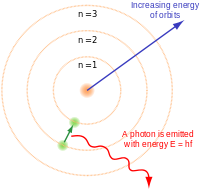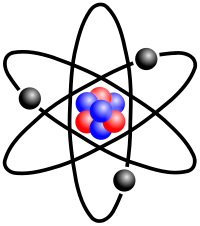Synchrotron radiation is produced when electrons, and other high -energy particles are forced to travel in a curved path by a magnetic field. It produces not only photons, but also X-rays. The magnetic field merely accelerates an existing rotational pattern of particles within the proton or neutron, and can because it is fluctuating, due to internal as well as external forces, force energy to escape what would otherwise be a stable rotational pattern.

Test particles in general relativity
In metric theories of gravitation, particularly general relativity, a test particle is an idealized model of a small object whose mass is so small that it does not appreciably disturb the ambient gravitational field.
According to the Einstein field equation, the gravitational field is locally coupled not only to the distribution of non-gravitational mass-energy, but also to the distribution of momentum and stress (e.g. pressure, viscous stresses in a perfect fluid).
In the case of test particles in a vacuum solution or electrovacuum solution,
this turns out to imply that in addition to the tidal acceleration
experienced by small clouds of test particles (spinning or not), spinning test particles may experience additional accelerations due to spin-spin forces.[2]
Test particles in plasma physics or electrodynamics
In simulations with electromagnetic fields the most important characteristics of a test particle is its electric charge and its mass. In this situation it is often referred to as a test charge.
An electric field is defined by  . Multiplying the field by a test charge qtest
gives an electric force exerted by the field on a test charge. Note
that both the force and the electric field are vector quantities, so a
positive test charge will experience a force in the direction of the
electric field.
. Multiplying the field by a test charge qtest
gives an electric force exerted by the field on a test charge. Note
that both the force and the electric field are vector quantities, so a
positive test charge will experience a force in the direction of the
electric field.
In a magnetic field, the behavior of a test charge is determined by effects of special relativity described by the Lorentz force. In this case, a positive test charge will be deflected clockwise if moving perpendicular to a magnetic field pointing toward you, and counterclockwise if moving perpendicular to a magnetic field directed away from you.
Remember page 61
" When high-energy particles are in rapid motion, including electrons forced to travel in a curved path by a magnetic field,
synchrotron radiation is produced.
Relativistic time contraction then bumps the frequency observed in the lab by another factor of γ, thus multiplying the GHz frequency of the resonant cavity that accelerates the electrons into the X-ray range. The radiated power is given by the relativistic Larmor formula while the force on the emitting electron is given by the Abraham-Lorentz-Dirac force."

We can do this by rewriting the Larmor formula in terms of momentum and then using the four vector generalisation of momentum (see four momentum), Pμ. We know that the power is a Lorentz invariant, so all we have to show is that our generalisation is also invariant and that it reduces to the Larmor formula in the low velocity limit.So;
Assume the generalisation;
When we expand and rearrange the energy-momentum four vector product we get;
where I have used the fact that  . When you let β tend to zero, γ tends to one, so that dτ tends to dt. Thus we recover the non relativistic case.
. When you let β tend to zero, γ tends to one, so that dτ tends to dt. Thus we recover the non relativistic case.
This is an interesting equation. It says that the power radiated by the particle into space depends upon its rate of change of momentum with respect to its time. It also says that the power radiated is proportional to the charge squared and inversely proportional to the mass squared. Thus for a highly charged, extremely small particle the radiation will be much greater than that for a large particle with a small charge.

Synchrotron radiation is the brightest artificial source of X-rays. The planar acceleration geometry appears to make the radiation linearly polarized when observed in the orbital plane, and circularly polarized when observed at a small angle to that plane. Amplitude and frequency are however focussed to the polar ecliptic.

A magnetic field is generated at right angles to the direction of rotation (north/south).
In astronomy, axial tilt (also called obliquity) is the angle between an object's rotational axis, and a line perpendicular to its orbital plane. It differs from inclination.
To measure obliquity, use the right hand grip rule for both the rotation and the orbital motion, i.e.: the line from the vertex at the object's centre to its north pole (above which the object appears to rotate counter-clockwise); and the line drawn from the vertex in the direction of the normal to its orbital plane, (above which the object moves counter-clockwise in its orbit). At zero degrees, these lines point in the same direction.
The planet Venus has an axial tilt of 177.3° because it is rotating in retrograde direction, opposite to other planets like Earth. The north pole of Venus is pointed 'downward' (our southward). The planet Uranus is rotating on its side in such a way that its rotational axis, and hence its north pole, is pointed almost in the direction of its orbit around the Sun. Hence the axial tilt of Uranus is 97°.[1]

To understand axial tilt, consider this blue solenoid in right hand grip rule as the rotational axis of Earth, the counter-clockwise direction of the magnetic field as the 'orbital plane' of Earth and the direction of the thumb pointing toward the north pole of Earth. In this figure, 'axial tilt' is zero degrees because the rotational axis is perpendicular to the orbital plane. If this blue solenoid (rotational axis) is tilted while the orbital plane remains fixed, then it is called the axial tilt of the planet or celestial body


